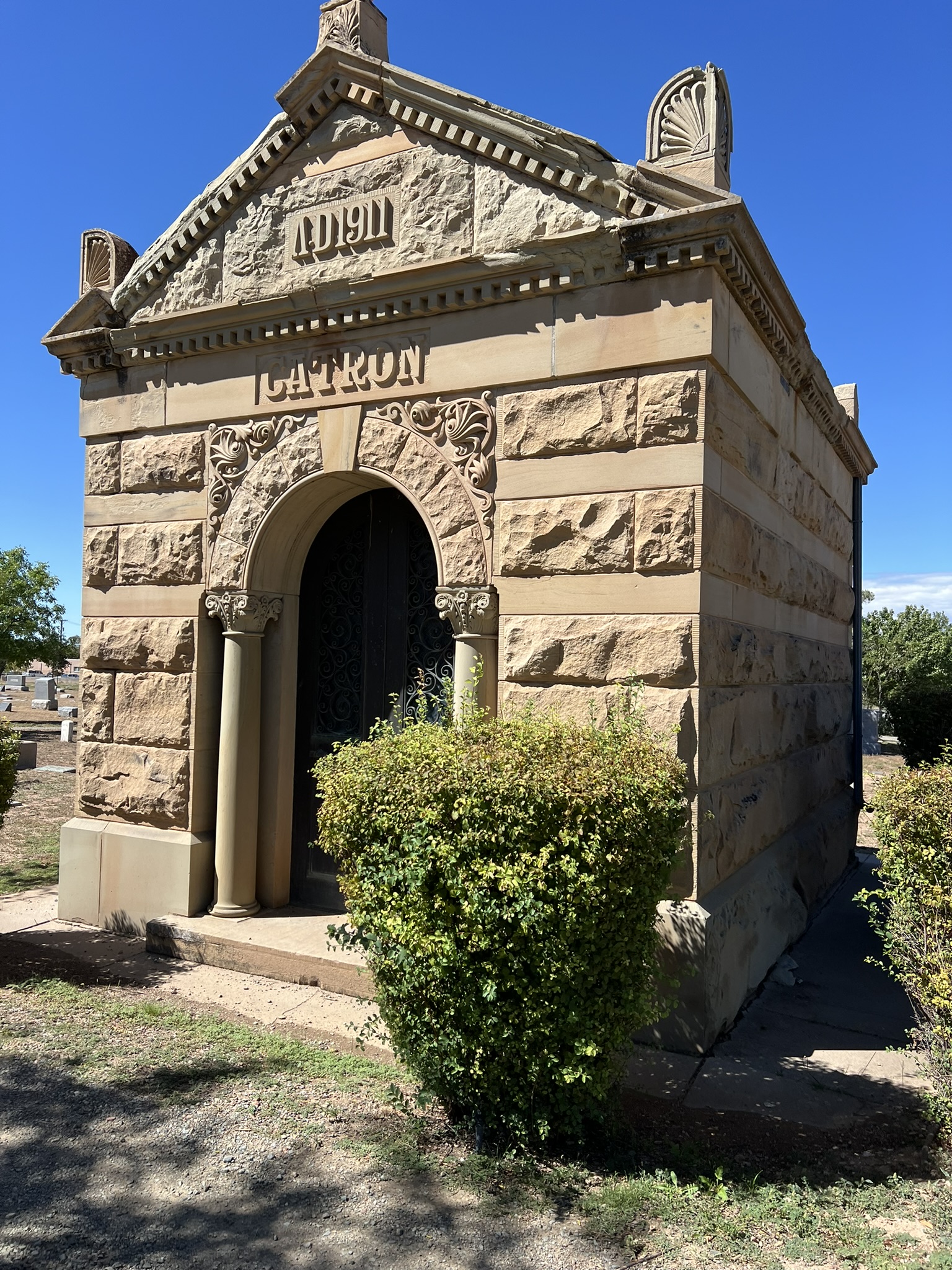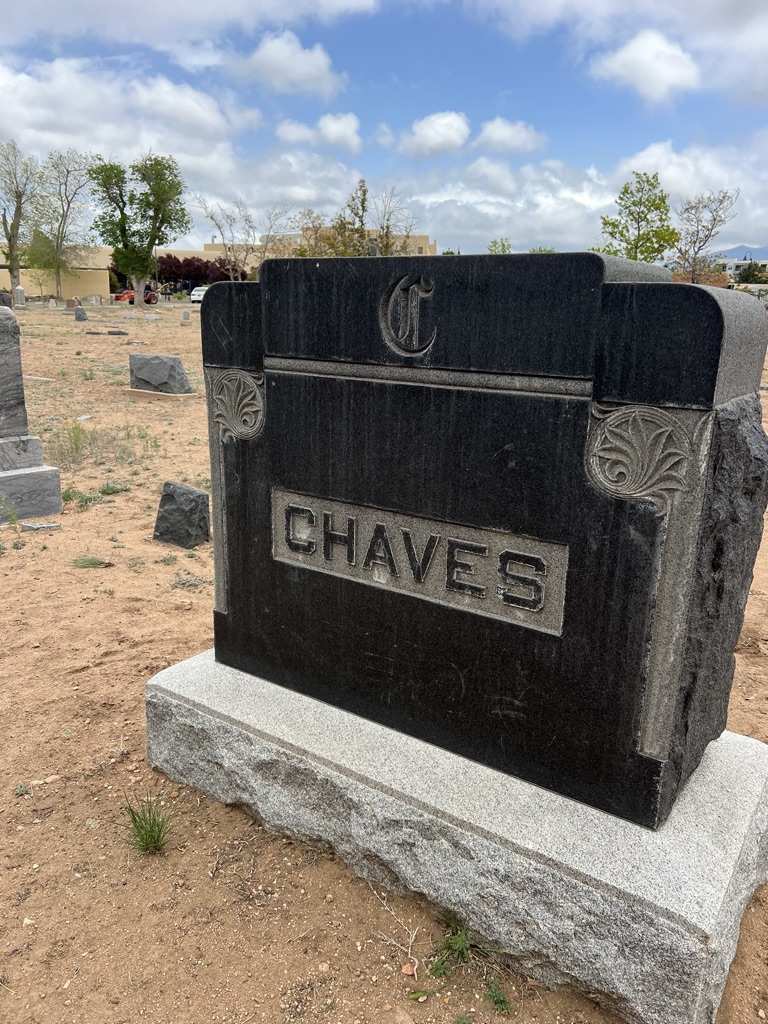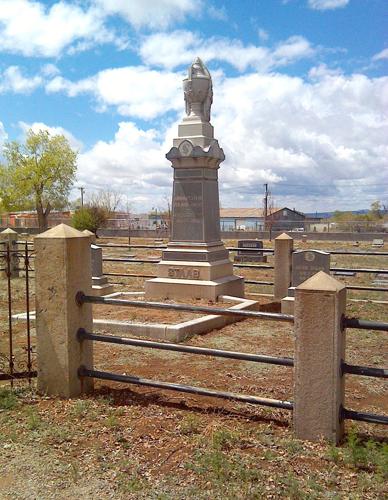We are the final resting place of many of Santa Fe’s illustrious and colorful citizens. We want to tell their stories in creative ways.
If you are a storyteller and would like to volunteer to lead tours or write a self-guided tour, please get in touch with us. fairviewcemetery@gmail.com
Check out the Santa Fe New Mexican’s article: Tales from the Crypt Click here
Here are snippets of history about a few Fairview Cemetery’s citizens:
(Ira Dymond) Gerald Cassidy (1869-1934) was born in Covington, Kentucky, and his family later moved to Cincinnati, Ohio. Cassidy studied there with painter Frank Duveneck at the Institute of Mechanical Arts. By the time he was 20, he was art director with a New York lithographer and was considered a master lithographer. In 1899 he was stricken by pneumonia and was sent to Albuquerque to recover. Several years later, he moved to Denver to work as a lithographer and commercial artist specializing in large theater posters.
He met Ina Davis, they married in 1912 and moved to Santa Fe. He became a founding member of he Santa Fe Arts Colony. He was commissioned by Edgar Hewitt to paint huge murals for the Panama-California Exposition of 1915 for which he won the gold medal.
In Santa Fe, he painted Native American people and landscapes, and his work can be seen in La Fonda, the Federal Building and the Post Office. Gerald died from carbon monoxide poisoning in an unventilated studio.
Nathan Howard (Jack) Thorp (1867-1940)
(The following taken from an article by historian Marc Simmons)
Jack Thorp was born in New York City but he had a romantic streak and
at age 19 set out for New Mexico. He first was a superintendent of a
silver mine at Kingston and then a cowboy in Lincoln County. One
evening, around a campfire near the Pecos River, he heard the cowhands
singing some old-time cowboy tunes and for the rest of his life he
traveled the Southwest collecting songs he had heard. In 1908, he
decided to put the best songs, along with some he wrote, into a book
which he titled “Songs of the Cowboys” (it included the words to “The Streets of Laredo”) and he paid the News Print Shop in Estancia to print
2,000 copies at six cents a copy. He sold the books for fifty cents. (Now
a rarity that might bring $2,000) A book written by Mark L. Gardner
about Jack and his songs and it included a CD of 17 songs. Jack’s wife, Annette worked with Ina Cassidy collecting history for the Federal Writer’s Project.
Perlina (Ina) Sizer (Davis) Cassidy (1869-1965) was born in Bent County, Colorado to a pioneer family who were homesteading. She began writing as a young woman, writing for several weekly newspapers in Colorado. During World War I, Ina was writing a book titled American National Foods, Edible Weeds, Etc. She wrote to Paul A.F. Walter about the book “I am rushing this food book out so it may save the nation.” She married, was widowed, then attended Columbia University where she became involved in the suffrage movement. She married Gerald Cassidy in Colorado, but they split their time between Santa Fe and New York City until 1920. Ina marched in New York and advocated in Washington, D.C. for the women’s right to vote. In 1920, after ratification of the 19th amendment, she established the League of Women Voters of Santa Fe County. Ina was a sculptress and also wrote a column in New Mexico Magazine for 30 years called Art and Artists. In 1935, Ina was appointed State Director of the New Mexico Federal Writers Project.
Arthur Seligman (1871-1933) was a prominent political leader who served as the Governor of New Mexico from 1931 until his death in 1933. He advocated for fiscal efficiency, promoted tourism, and funded the state historical society. Prior to his governorship, Seligman was the Mayor of Santa Fe from 1910 to 1912, during which time he oversaw the city’s first pavement installation. He also held roles as Chairman of the Santa Fe County Commission from 1910 to 1920 and president of the Educational Survey Commission from 1921 to 1923. Additionally, he was a delegate to the Democratic National Committee from 1920 to 1933. In the business sector, Seligman was president of the First National Bank of Santa Fe and the La Fonda Building Corporation, which operated a major hotel. He was one of only four Jewish U.S. governors during his tenure and died of a heart attack while in office.
Thomas B. Catron (1840-1921) T.B. Catron was born in Lexington, Missouri. He served in the Confederate Army in the Civil War. After the war, he returned home with the intention of practicing law, however
Missouri had passed a law that you could not practice law if you had borrne arms against the United States. He chose to move to the New Mexico Territory in 1866 where he learned Spanish, studied law and began a law practice. He was a central figure in the controversial Santa Fe Ring, a group of lawyers and politicians who controlled vast amounts of land and influenced politics. He was appointed Attorney General of the New Mexico Territory in 1869 and served as United States Attorney for the New Mexico District from 1872 to 1878. He was elected to the New Mexico Territorial Council, later was a delegate to Congress, and Santa Fe Mayor in 1906. When New Mexico was granted statehood in 1912, Catron was elected one of the first two senators. He married Julia Walz (1857–1909) in 1887, and they had four sons and also a daughter who died in infancy. Two of their sons followed him into law practice, as did his grandson Thomas B. Catron lll, his great-grandson Fletcher R. Catron, and his great great granddaughter Julia Catron making the Catron Law Firm the oldest law firm in New Mexico.
The Catron Mausoleum at Fairview Cemetery is the oldest and most prominent of the cemetery’s three mausoleums, built when his wife Julia died, and she, he and their infant daughter are buried in the mausoleum. Stephen Catron, (1949-1985), the son of Thomas B. Catron III and June Catron, is buried next to the Catron Mausoleum.
Chaves Legacy: Amado Chaves (1850-1930) was a significant figure in New Mexico’s history, serving as the first Superintendent of Public Instruction for the Territory of New Mexico in 1891. He was also elected Mayor of Santa Fe in 1891 and served as a Senator in the Territorial Council in 1903. He was also a lawyer. His wife: Kate Nichols Chaves (1868–1916) is recognized as one of New Mexico’s earliest documented female architects. She designed and supervised the construction of the Kate Nichols Chaves House at 501 11th Street NW in Albuquerque in 1909. Prior to marrying Amado, she was married to Stephen Burton Foster (died 1890) and they had one son Samuel Pettingill Foster (1890-1893). Her parents James Nichols (1829-1885) and Georgianna B. Nichols (1833–1935), sister Ivey Nichols Baucus (1879-1954) and Ivey’s husband George Baucus (1861-1936) along with 2 other sister Nancy Nichols Albright (1871-1888) and Georgiana Nichols (1874-1887) and Amado’s brother Ireneo Chaves (1855-1946) an interpreter for the courts and ancient Spanish documents are also buried at Fairview.
Chaves had 2 daughters: Katherine (Kia) and Consuelo, and one son Amado Jr. (1898–1928) who was the American Vice Consul to Venezuela.They all spent the summers exploring the mountains. He built and ran Los Pinos Guest Ranch at the edge of the Pecos Wilderness, which is still in operation today. His daughter Katherine (Kia) Chaves Page Kavanagh (1894–1961) took over Los Pinos Guest Ranch when her father died in 1930 and ran it till her death. She loved fishing and riding horses and on one ride she discovered Lake Katherine, a pristine lake in the wilderness. She blazed the trail and some of the markings are still standing today. She oulived 2 husbands Bernard Wintrop (BW) Page (1867-1932) was the manager of Bishops Lodge and Charles Kavanagh (1900- 1954) was a contractor and served in the US Army, who are also buried at Fairview.
Consuelo Mercedes Chaves Summers (1902–1990) Worked with ethnographer Charles Fletcher Lummis, aiding his documentation of New Mexico’s Hispanic heritage. Described as his “best friend in New Mexico” during his final research trip. She also was instrumental in providing old documents to Marc Simmons, a renowed New Mexico author. The Amado Chaves papers (1698–1931) are housed at the New Mexico State Records Center and Archives in Santa Fe. She contributed to New Mexico’s infrastructure at the Highway Department and worked in in doctor’s offices. She volunteered at St. Vincent Hospital and channeled her love for gardening into maintaining Fairview Cemetery, where her dishes were a highlight at the Annual Spring Clean Up & Potluck. Her husband OB Summers (1892-1954) who was president of New Mexico Power Company, and her had two children Amado Chaves Summers Sr. (1932–2015) and Baby Summers, a stillborn girl (1933). O.B later divorced Consuelo and then remarried her. He then divorced her, moved to Los Alamos and married his secretary Bernadette. They had 5 children. Upon his death, his wife called Consuelo and asked for him to be buried in her family plot at Fairview. Consuelo never remarried. Consuelo was a vital part in her grandchildren lives and her famous “Nanny’s Coffee Cake” is a family tradition on Christmas morning.
Amado worked 30 years at Mountain Bell and then 12 years with the New Mexico Legislature after retirement. He was passionate about his horses, dogs, his family and riding in the Pecos Wilderness. He met Eva Ruth Jaggers Summers (1929–2018) on the Santa Fe Ski slopes and were married for 63 years. Ruth was a teacher at Carlos Gilbert Elementary School, a Girl Scouts leader for 25 years, avid reader, and loved being outdoors. She was a Storyteller for 14 years at the Valley School in Ribera. She also taught Vacation Bible School for many summers at St. Pauls Peace in Las Vegas, New Mexico. Amado and Ruth actively supported their four children Kathy, Amado Jr., Nancy and Carrie and their grandchildren.
Amado is a past president of Fairview Cemetery Preservation Association and along with Ruth were instumental in taking care of Fairview. Carrie Summers, currently the acting President of Fairview Cemetery, continues to preserve the family’s legacy as part of Santa Fe’s historical fabric.


